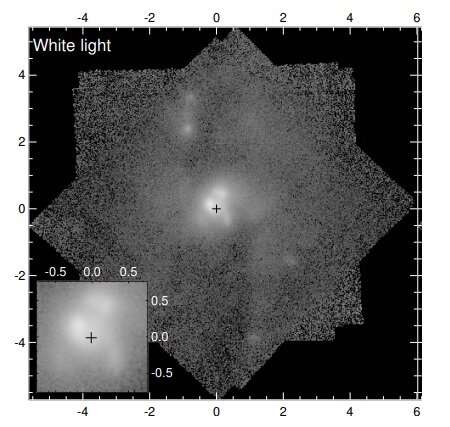White light image of the center of NGC 7130 obtained from integrating the reduced MUSE datacube along the spectral direction. Credit: Comerón et al., 2020.
Using ESO's Very Large Telescope (VLT), astronomers have investigated ionized gas in the central regions of the Seyfert galaxy NGC 7130. In their study, they identified a complex multi-component outflow in this galaxy. The finding is reported in a paper published November 5 on arXiv.org.
Active galactic nuclei (AGN) are accreting supermassive black holes (SMBHs) residing at the centers of some galaxies, emitting powerful, high-energy radiation as they accrete gas and dust. Outflows are assumed to be part of the self-regulation mechanism for the growth of SMBHs.
At a distance of some 212 million light years away, NGC 7130 (also known as IC 5135) is a luminous infrared galaxy (LIRG) with an AGN classified as Seyfert type 1.9. The center of this galaxy hosts two dusty spiral arms within the bar, coinciding with molecular gas. Previous observations also detected extended carbon monoxide emission that may be partially correlated with the star-forming ultra-compact nuclear ring (UCNR) in NGC 7130.
A team of astronomers led by Sébastien Comerón of the University of La Laguna, Spain, performed a study of the innermost parts of NGC 7130 with the aim of better understanding how its AGN is fed and how it affects its surroundings. For this purpose, the researchers used VLT's Multi Unit Spectroscopic Explorer (MUSE).
"The laser guide star adaptive optics mode for MUSE at the VLT now permits to study the innermost tens of parsecs of nearby AGNs in the optical. We present a detailed analysis of the ionized gas in the central regions of NGC 7130, an archetypical composite Seyfert and nuclear starburst galaxy at a distance of 64.8 Mpc," the authors of the paper explained.
The observations identified nine kinematic components, six of which correspond to the NGC 7130's AGN outflow. The detected outflow appears to be biconic, and was found to be oriented in an almost north-south direction. It has velocities of a few 100 km/s with respect to the disc of the galaxy.
The ionized gas mass outflow rate and the kinetic power of the outflow were calculated to be 1.5 solar masses per year and 340 duodecillion erg/s, respectively. The kinetic power was measured to be at a level of approximately 0.15 percent of the bolometric AGN output. The astronomers noted that these values are comparable to those of other known AGN and about few times smaller than the star formation rate of NGC 7130.
In concluding remarks, the researchers emphasized the importance of MUSE when it comes to disclosing the complexity of AGN outflows.
"Our study has once again proven the extraordinary quality of MUSE data, the finesse of which is such that it fully reveals the complexity of the multi-component outflow. Although multicomponent ionized outflows have already been observed, none has to our knowledge required the many kinematic components that we have used in our description," the scientists concluded.
More information: Comerón et al., The complex multi-component outflow of the Seyfert galaxy NGC 7130, arXiv:2011.02937 [astro-ph.GA] arxiv.org/abs/2011.02937
© 2020 Science X Network
























